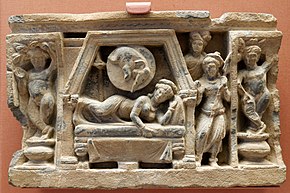Maya (mother of the Buddha)

Maya (sometimes also Māyā) was - according to Buddhist tradition - the birth mother of the Buddha . She is also known as Mahamaya ("Great Maya") or Mayadevi ("Queen Maya", "Goddess Maya"). In Tibetan Buddhism her name is Gyutrulma . Her name means something like "enchantment" or "illusion", which is associated with her extraordinary beauty.
Lore
Maya was the wife of King Śuddhodana of the Shakyas tribe in Kapilavastu and the birth mother of the Buddha . After the marriage to King Śuddhodana had not had children for 20 years, Maya dreamed on a full moon night that she was being abducted by heavenly spirits ( devas ) to a lake in the mountains of the Himalayas ; After bathing in the lake, the devas dressed her in heavenly robes, sprinkled her with precious perfume and sprinkled her with petals. In her sleep a white elephant with a lotus flower on its tusk appeared to her, circled her three times and then entered her through her right side. Later the elephant disappeared, but after waking up she knew that something very special had happened to her, because elephants - especially white ones - are seen in Asia as embodiments or symbols of power and being chosen.
After ten months of pregnancy, she is said to have started a trip to her parents' house in Devadaha to give birth there, but halfway there she was standing near today's city of Lumbini ( Nepal ) - standing and leaning on the branches of a sal tree (Shorea robusta) , who in ancient scriptures was often confused with an Ashoka tree (Saraca asoca) , holding on to - a son who was given the name Siddhartha was born. According to tradition, the birth is said to have taken place on the right side of Maya; she died seven days after giving birth. According to Buddhist tradition, all of this happened in 563 BC. BC (this dating has been questioned some time ago). Her son was raised by her sister Mahapajapati Gotami , who also became King Śuddhodana's second wife.
After Siddharta had attained enlightenment and became a Buddha (Sanskrit: "awakened" or "enlightened"), he visited his mother in heaven for three months, showed her respect and instructed her in the teaching of the Dharma .
Buddhism and Christianity
The Christian and the Buddhist tradition have certain parallels with regard to the virgin conception , the birth of the son on a journey and the - through the formation of legends or from the evangelists Matthew ( Mt 1,1-17 EU ) and Luke ( Lk 3,23- 38 EU ) self-constructed - royal descent. But there are also clear differences - e.g. B. Mary did not die after the birth of her divine Son.
Greek and Roman mythology
It is also worth mentioning that the name is identical to Maia , the mother of the Greek messenger of the gods Hermes , who was impregnated by Zeus at night . A Roman goddess of fertility also bears the name Maia.
Individual evidence
- ↑ Wilhelm Heinrich Roscher (Ed.): Detailed lexicon of Greek and Roman mythology. Leipzig 1897, Col. 2234 ff.
literature
- Miranda Shaw: Buddhist Goddesses of India. Princeton University Press 2006, ISBN 0-691-12758-1 , pp. 45 f.
- Hans Wolfgang Schumann: Buddhism. Donors, schools and systems. Diederichs, Munich 1993, ISBN 3-424-01461-3 , p. 14 f.
Web links
- Dream of Queen Maya (Engl.)
| personal data | |
|---|---|
| SURNAME | Maya |
| ALTERNATIVE NAMES | Mahamaya; Mayadevi |
| BRIEF DESCRIPTION | Mother of the Buddha |
| DATE OF BIRTH | 6th century BC Chr. |
| DATE OF DEATH | 6th century BC Chr. |

